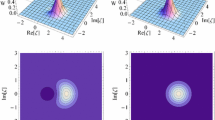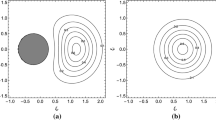Abstract
In this paper, we theoretically prove that the Gaussian quantum discord state of optical field can be used to complete continuous variable (CV) quantum key distribution (QKD). The calculation shows that secret key can be distilled with a Gaussian quantum discord state against entangling cloner attack. Secret key rate is increased with the increasing of quantum discord for CV QKD with the Gaussian quantum discord state. Although the calculated results point out that secret key rate using the Gaussian quantum discord state is lower than that using squeezed state and coherent state at the same energy level, we demonstrate that the Gaussian quantum discord, which only involving quantum correlation without the existence of entanglement, may provide a new resource for realizing CV QKD.





Similar content being viewed by others
References
Ollivier H, Zurek WH (2001) Quantum discord: a measure of the quantumness of correlations. Phys Rev Lett 88:017901
Modi K, Brodutch A, Cable H et al (2012) The classical-quantum boundary for correlations: discord and related measures. Rev Mod Phys 84:1655–1707
Aaronson B, Franco RL, Compagno G et al (2013) Hierarchy and dynamics of trace distance correlations. New J Phys 18:093022
Knill E, Laflamme R (1998) Power of one bit of quantum information. Phys Rev Lett 81:5672–5675
Ryan CA, Emerson J, Poulin D et al (2005) Characterization of complex quantum dynamics with a scalable NMR information processor. Phys Rev Lett 95:250502
Lanyon BP, Barbieri M, Almeida MP et al (2008) Experimental quantum computing without entanglement. Phys Rev Lett 101:200501
Giorda P, Paris MGA (2010) Gaussian quantum discord. Phys Rev Lett 105:020503
Adesso G, Datta A (2010) Quantum versus classical correlations in Gaussian states. Phys Rev Lett 105:030501
Gu M, Chrzanowski HM, Assad SM et al (2012) Observing the operational significance of discord consumption. Nat Phys 8:671–675
Blandino R, Genoni MG, Etesse J et al (2012) Homodyne estimation of Gaussian quantum discord. Phys Rev Lett 109:180402
Madsen LS, Berni A, Lassen M et al (2012) Experimental investigation of the evolution of Gaussian quantum discord in an open system. Phys Rev Lett 109:030402
Weedbrook C, Pirandola S, García-Patrón R et al (2012) Gaussian quantum information. Rev Mod Phys 84:621–669
Grosshans F, Cerf NJ, Wenger J et al (2003) Virtual entanglement and reconciliation protocols for quantum cryptography with continuous variables. Quantum Inf Comput 3:535–552
Iblisdir S, Van Assche G, Cerf NJ (2004) Security of quantum key distribution with coherent states and homodyne detection. Phys Rev Lett 3:170502
Grosshans F (2005) Collective attacks and unconditional security in continuous variable quantum key distribution. Phys Rev Lett 94:020504
Navascués M, Acín A (2005) Security bounds for continuous variables quantum key distribution. Phys Rev Lett 94:020505
Renner R, Cirac JI (2009) A de Finetti representation theorem for infinite-dimensional quantum systems and applications to quantum cryptography. Phys Rev Lett 102:110504
Leverrier A, Grangier P (2009) Unconditional security proof of long-distance continuous-variable quantum key distribution with discrete modulation. Phys Rev Lett 102:180504
Weedbrook C, Pirandola S, Ralph TC (2012) Continuous-variable quantum key distribution using thermal states. Phys Rev A 86:022318
Pirandola S. Quantum discord as a resource for quantum cryptography. arxiv:quant-ph/1309.2446
Simon R (2000) Peres–Horodecki separability criterion for continuous variable systems. Phys Rev Lett 84:2726–2729
Werner RF, Wolf MM (2001) Bound entangled Gaussian states. Phys Rev Lett 86:3658
Serafini A, Illuminati F, De Siena S (2004) Symplectic invariants, entropic measures and correlations of Gaussian states. J Phys B 37:L21
Adesso G, Serafini A, Illuminati F (2004) Extremal entanglement and mixedness in continuous variable systems. Phys Rev A 70:022318
Navascués M, Grosshans F, Acín A (2006) Optimality of Gaussian attacks in continuous-variable quantum cryptography. Phys Rev Lett 97:190502
García-Patrón R, Cerf NJ (2006) Unconditional optimality of Gaussian attacks against continuous-variable quantum key distribution. Phys Rev Lett 97:190503
Pirandola S, Braunstein SL, Lloyd S (2008) Characterization of collective Gaussian attacks and security of coherent-state quantum cryptography. Phys Rev Lett 101:200504
Namiki R, Hirano T (2004) Practical limitation for continuous-variable quantum cryptography using coherent states. Phys Rev Lett 92:117901
Brassard G, Salavail L (1993) Secret-key reconciliation by public discussion. In: Helleseth T (ed) Advances in Cryptology—Eurocrypt’93 Lecture Notes in Computer Science. Springer, New York, pp 410–423
Bennett CH, Brassard G, Crépeau C et al (1995) Generalized privacy amplification. IEEE Trans Inf Theor 41:1915–1923
Cachin C, Maurer UM (1997) Linking information reconciliation and privacy amplification. J Cryptol 10:97–110
Holevo AS, Sohma M, Hirota O (1999) Capacity of quantum Gaussian channels. Phys Rev A 59:1820–1828
Grangier P, Levenson JA, Poizat JP (1998) Quantum non-Demolition measurements in optics. Nature 396:537–542
Eisert J, Scheel S, Plenio MB (2002) Distilling Gaussian states with Gaussian operations is impossible. Phys Rev Lett 89:137903
Fiurášek J (2002) Gaussian transformations and distillation of entangled Gaussian states. Phys Rev Lett 89:137904
Grosshans F, Grangier P (2002) Continuous variable quantum cryptography using coherent states. Phys Rev Lett 88:057902
Grosshans F, Van Assche G, Wenger J et al (2003) Quantum key distribution using gaussian-modulated coherent states. Nature 421:238–241
Lu ZX, Yu L, Li K et al (2010) Reverse reconciliation for continuous variable quantum key distribution. Sci China Phys Mech Astron 53:100–105
Silberhorn C, Ralph T C, Lütkenhaus N et al (2002) Continuous variable quantum cryptography: beating the 3 dB loss limit. Phys Rev Lett 89:167901
Weedbrook C, Lance AM, Bowen WP et al (2004) Quantum cryptography without switching. Phys Rev Lett 93:170504
Acknowledgments
The author thanks for helpful discussion with Prof. Changde Xie, Kunchi Peng, Jing Zhang, and Xiaojun Jia. This work was supported by the National Basic Research Program of China (2010CB923103), the National Natural Science Foundation of China (11174188, 61121064), Shanxi Scholarship Council of China (2012-010) and Program for the Outstanding Innovative Teams of Higher Learning Institutions of Shanxi.
Author information
Authors and Affiliations
Corresponding author
About this article
Cite this article
Su, X. Applying Gaussian quantum discord to quantum key distribution. Chin. Sci. Bull. 59, 1083–1090 (2014). https://doi.org/10.1007/s11434-014-0193-x
Received:
Accepted:
Published:
Issue Date:
DOI: https://doi.org/10.1007/s11434-014-0193-x




